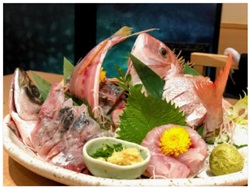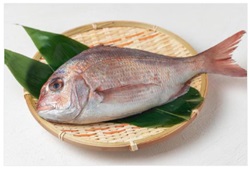In Japan, tai is used both as a general name for saltwater fish of the family Sparidae and specifically for the madai, a popular species in Japan.
The tai is regarded as a celebratory fish and is often served at ceremonious occasions such as weddings.
Tai has long been essential at cerebration as the name is a pun on medetai(auspicious)and
god Ebisu carries one under his arm.

tai sashimi
Of the approximately 120 species of Sparidae known worldwide, 11 are found in Japan; these resemble the sea bream of the United States. The madai is native to Japan and its vicinity; it grows to over 80cm(32in).
Over 200 species of fish that are not of the family Sparidae, but that have slightly flattened bodies, are given names suffixed with -tai, indicating the popularity of the tai itself. it is eaten raw, broiled with salt, or in soups.
Bones of the madai and tai have been found in arachaeological sites from the Jomon period(ca 10,000 BC-ca 300 BC).

Poems praising the taste of tai are found in the 8th-century anthology, the Manyoushuu. However, it was only with the development of the fishing industry in the early modern period that the common people came to eat tai.

